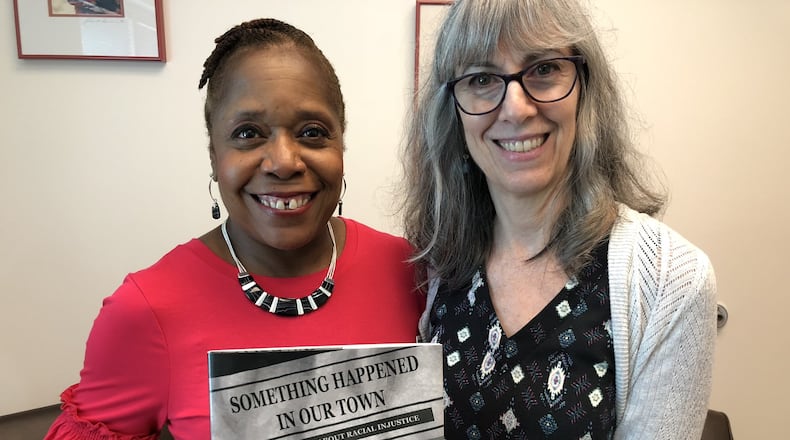Michael Brown, Eric Garner, 12-year-old Tamir Rice.
As a series of high-profile killings of black men and boys by police officers shook the country, Atlanta child psychologists and longtime colleagues Dr. Marietta Collins, Dr. Marianne Celano and Dr. Ann Hazzard wanted to do something to spark conversations about racial injustice, counter negative stereotypes and encourage young people to embrace people of all races, cultures and backgrounds. Collins, Celano and Hazzard decided to write a children's book that tackles not only police shootings but systematic racism going back centuries.
The trio, who met more than 25 years ago as faculty members at Emory University School of Medicine, started penning a book titled "Something Happened in Our Town" about two years ago. The book features two families — a white family and a black family — as they both discuss a police shooting of a black man.
Published by Magination Press, which is the children's book imprint of the American Psychological Association, the new book, which retails for $16.99, was originally scheduled to be released later this summer, but was moved up after the shooting of 22-year-old Stephon Clark in the yard of his grandmother's home. Sacramento, Calif., police said officers believed he was holding a gun, but only a cellphone was recovered. No charges have been filed against the two police officers in Clark's case — or against the police officers in the cases of Brown, Garner and Rice. The shooting of Clark sparked protests and outrage.
Credit: Family photo via AP
Credit: Family photo via AP
The book, designed for children ages 4-8, is direct in its approach.
The book begins like this:
Something bad happened in our town. The news was on the TV, the radio and the internet. The grown-ups didn’t think the kids knew about it. But the kids in Ms. Garcia’s class heard some older kids talking about it, and they had questions.
The book discusses a police shooting, and then parents and children have a conversation about a pattern of racial bias and injustice in our country. The authors said they wanted to make clear that police killings of unarmed black children and men should not be viewed as flawed action on the part of individual police officers, but as a consequence of the broader problem of structural racism. The book discusses ways to confront and change this pattern, and in the book, they use the pattern of a metaphor to illustrate the point. The white mother asks her daughter, Emma — suppose you had a birthday party and invited everyone in your class except the black kids.
“They would be sad,” Emma said. “Or mad.”
“And YOU would be missing out, because you never know who is going to be your best friend,” said Liz, her sister.
When the book switches to a black family, a young boy named Josh is troubled by the news of a police shooting.
His father tells him there are many cops, black and white, who make good choices, but adds, “We can’t always count on them to do what’s right.”
The book includes an extensive resource guide with multiple pages devoted to helping parents with everything from how to address racial bias with children to how to respond if your child tells a racist joke or makes a sweeping comment about black boys in class.
“We don’t want families to just read the book,” said Collins, who is black and who worked on Emory’s Transforming Community Project (TCP), an initiative to document the university’s past and confront current challenges around the issue of race. “We want it to be interactive. We want it to be a springboard for conversations about bias and prejudice.”
When asked about the current state of racial justice and harmony today, Collins, who recently retired from Emory and now works as the director of behavioral medicine at Morehouse School of Medicine, responded:
“It’s definitely not better.”
GUIDANCE FOR PARENTS
The following is an excerpt from the resource and guidance section of the book “Something Happened in Our Town”:
— Take the time to address your child's questions or comments. Do not ignore or sidestep them with blanket reassurances (e.g., "We are all the same inside").
— If your child makes a negative racial comment, ask him or her in a nonjudgmental tone, “What makes you say that?” Your child’s answer may provide an opportunity to counter generalizations or to increase empathy.
— Encourage multidimensional views of others. Preschoolers tend to view people as all good or all bad. You can help your child to recognize human complexity and learn to consider both similarities and differences between people in appearance, feelings, preferences and behaviors.
— Balance your acknowledgment of the reality of racism with messages about hope for change and the availability of help.
— Be prepared to talk about what your child sees and hears. He or she may need help in understanding community events or news stories. It may be difficult to limit your child’s exposure to graphic images or overly detailed information about community violence, but try to do so to avoid inducing undue anxiety.
MORE: 'Jesus Junior'? 'Not a perfect person'? Finding the real MLK in 2018
MORE: Special King's Final Year
MORE: Kanye ♥ Donald: Why can't black Americans support Trump?
About the Author
Keep Reading
The Latest
Featured


